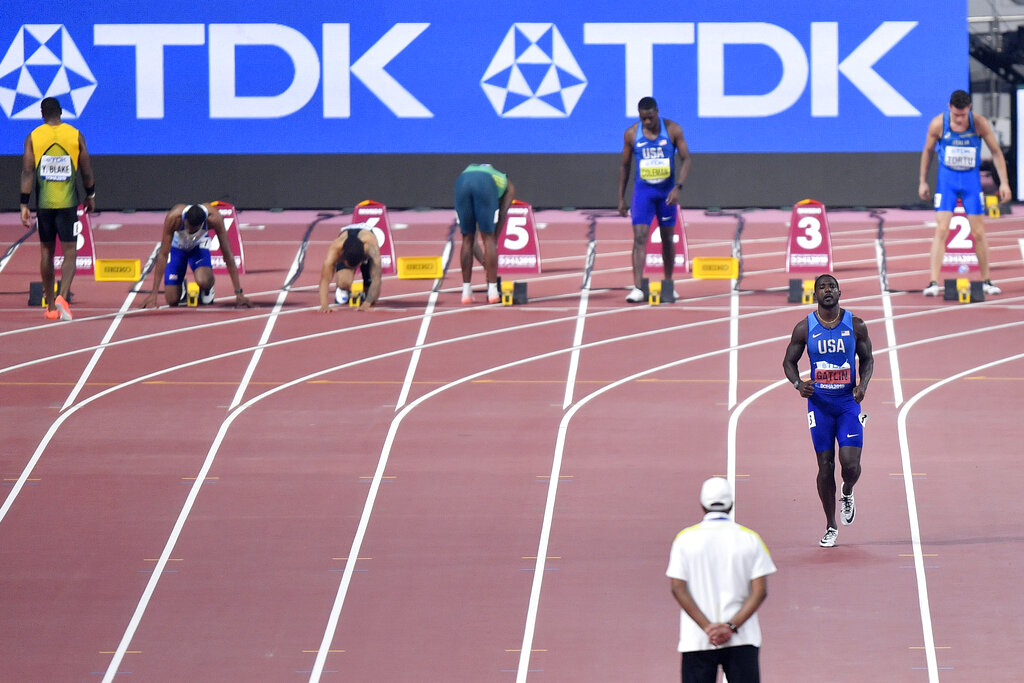
Justin Gatlin, of the United States, foreground right, and other athletes get ready for the men’s 100 meter race during the World Athletics Championships in Doha, Qatar, Saturday, Sept. 28, 2019. (AP Photo/Martin Meissner)
DOHA, Qatar— With cameras in the starting blocks peering up the legs of athletes into their eyes, television viewers have been taken closer to the action than ever before at the world championships.
Just too up close and personal for some athletes.
“I’m not too keen about it because it’s kind of invading my private space in a sense,” said Akani Simbine, the South African who finished fourth in Saturday’s 100-meter final. “Being in the blocks is one of the athlete’s sacred spaces and that’s the point where you just want to be alone and be free.
“You have a camera in your face and you don’t really want to have a camera in your face.”
Justin Gatlin was prepared for cameras capturing him from the new unaccustomed angles.
“I made sure I had my lucky underwear on,” said the American who got a silver in the 100 meters.
For others, the perceived invasion of privacy wasn’t a laughing matter. The backlash against the intrusive angles started as soon as athletes started to receive images from the “crotch cams.”
“My friends told me the pictures weren’t very flattering,” said Dina Asher-Smith, British silver medalist in the women’s 100 meters.
An official complaint came from the German track and field federation. It led to the competition organizers rolling back the use of the cameras that were introduced in Doha as part of a technology push to attract new viewers. They’ve also introduced pre-race dimming of the lights and graphics being projected on the track.
“We have noted some specific feedback about the block cameras and we have confirmed we have appropriate measures in place to protect athlete privacy during the process of selecting images for broadcast,” the IAAF said in a statement.
“We also have strict editorial guidelines for what is broadcast and these have been observed since the beginning of the championships.”
The IAAF installed the two miniature cameras in the starting blocks to capture what it called the “explosion of energy” from athletes who were only previously seen from above or the side of their heads.
Not all competitors objected to the unfamiliar angles.
“It’s pretty cool for the fan base they get to see us in the blocks,” said Andre de Grasse, the Canadian who finished third in the 100 final behind Christian Coleman and Gatlin. “But you can’t get distracted by it. You’ve just got to focus on your race and not look too much toward the camera.”
De Grasse was surprised to be informed by one viewer that his eyes were closed briefly.
Filippo Tortu’s father and coach spotted that, too, during sprints in Khalifa International Stadium.
“He didn’t know that I start with closed eyes,” the Italian said. “He saw on the camera and said, ‘You are the only one in the world that does that. Why? Why? Why?’
“But I think it’s a very positive thing to do more for television. It’s important for us.”
Mimicking the whirring sound, British sprinter Zharnel Hughes welcomed the IAAF innovating but not the execution of the technology.
“Sometimes you hear camera inside the blocks,” he said. “It’s a cool feature but it’s a bit scary at the same time because it’s looking up your nose. You aren’t looking at it. You know it’s there because when you are set on your blocks you hear it.”
Offering new camera angles, though, will count for little it the actual competition isn’t a spectacle.
“People want to see competitive races,” Coleman said after winning the world 100 title. “That’s what will really promote the sport.”